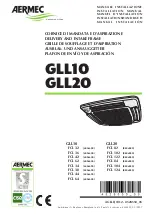
IM 368 / Page 12 of 20 (Rev 11/03)
Units that are furnished with remote mounted thermostats should
be wired as shown in Figure 17. Other considerations for this
arrangement are as follows:
1. When wiring the low voltage plug and receptacle disconnect,
provide enough wire to move harness out of the way for
chassis removal.
2. If subbase is used, a small hole must be drilled and grommeted
in the subbase front to allow passage of the low voltage wires.
3. If slave units are to be employed, connect as shown in Figure
17. With this arrangement, the loop between terminals N2
and N4 of the slave unit must be severed. The standard
master transformer handles 10 VA power draw and each slave
unit draws 5 VA. If more than one slave unit is used, the
master transformer must be replaced with a larger one. The
number of slave units that can be connected is limited to the
maximum amperage rating of the thermostat contacts.
4. When using a programmable wall thermostat, splice into the
jumper going from N2 to N4 of the master unit and connect it
to the common terminal of the thermostat. Refer to the
instructions furnished with the chosen thermostat to locate
the common terminal. Note: It may be necessary to place a
larger VA transformer in the unit when using certain
programmable thermostats. Check the VA draw of the
chosen thermostat, plus a VA draw of the slave unit to be
sure it does not exceed 10 VA power draw. Slave units are
connected as described in #3 above.
Incremental conditioners are built to last. With proper care, the
unit should provide uninterrupted service for many years.
Scheduled maintenance of this equipment, as described below,
is the key to the equipment’s longevity.
A. Air filters must be cleaned at regular intervals. Twice annually
may be adequate in some areas while twice monthly may be
required in others. Areas with high dirt and lint content or heavy
usage of units require more frequent filter maintenance than
those areas of relatively clean operating or low usage
conditions. Unit malfunction may occur if air filters are not kept
clean. Rinse filters with hot water and a mild detergent. Let
dry and oil lightly to enhance dust collecting ability.
B. McQuay recommends that every year the chassis be removed
for a thorough checkup. This should be completed as follows:
1. Unplug unit from power source.
2. Remove front panel.
3. Remove chassis from cabinet and move it to the
maintenance department. Replace with spare chassis or
weather plate.
4. Check all seals and insulation and repair as required.
5. Check all wiring and controls for hazardous conditions.
6. Thoroughly clean discharge grilles.
7. Cover motors and control module with watertight
material and wash evaporator coil, condenser coil and base
pan using hot water and a mild soap.
8. Clean condensate drain and clear weep holes.
9. Dry equipment thoroughly, especially electric parts and
insulation.
10. Clean any rust spots with steel wool and paint with rust
inhibiting paint.
11. Clean insulation or replace if necessary.
12. Check insulation on suction tube and replace if necessary.
13. Check all fasteners and tighten as required.
14. Clean and oil damper door and linkage.
15. Test run chassis before reinstalling or returning to spare
parts stock.
Installing Remote Mounted Thermostat
Scheduled Maintenance
Residential and institutional cleaning compounds can
cause permanent damage to the packaged terminal unit.
To avoid damage to unit controls and heat transfer
surfaces, do not spray cleaning compounds onto the
discharge grille, return air opening, or unit controls.
Normal cleaning can be accomplished by wiping the unit
surface with a damp cloth. When using cleaning
compounds on carpets, floors or walls, turn the unit off to
avoid drawing potentially damaging vapors into the
package terminal unit.
WARNING
Figure 17.
Optional Wall Plate
Temperature
Fall
System
Switch
Heat
Off
Cool
On
Auto
Fan
Switch
See Note
3 Above
Low
Voltage
Plug &
Receptacle
Disconnect
Wires from Control
Master Unit
Wires from Control
Slave Unit






































